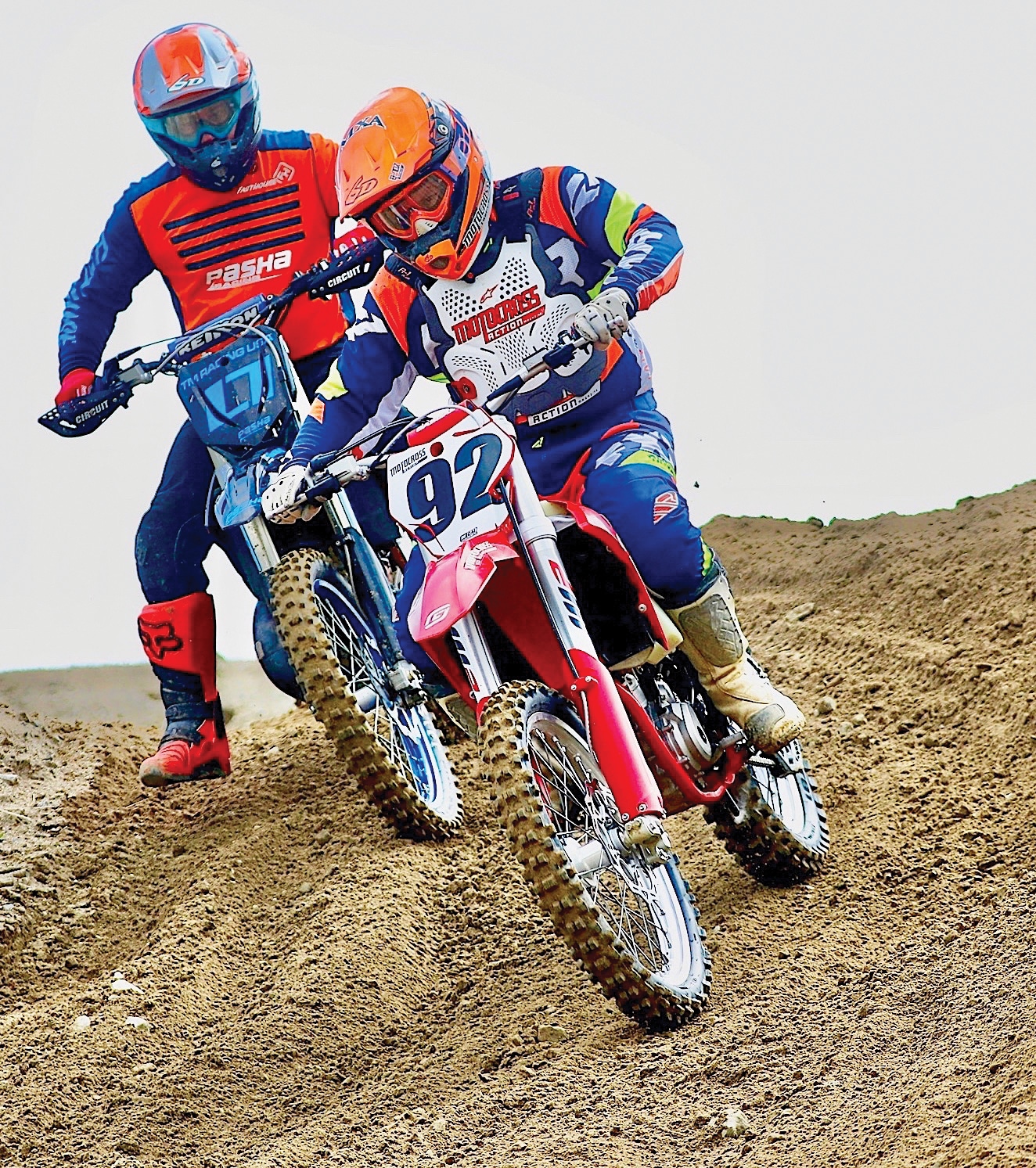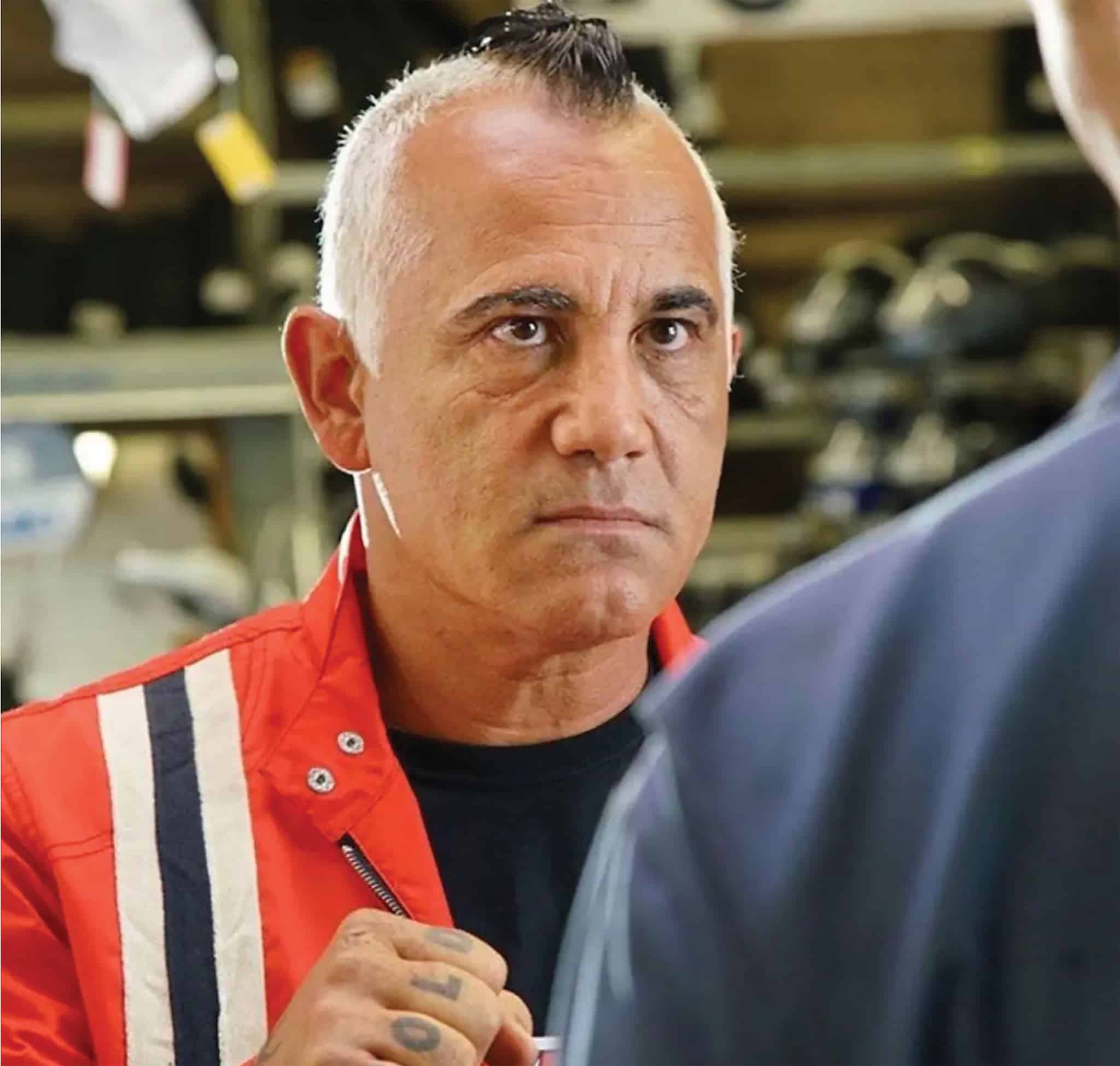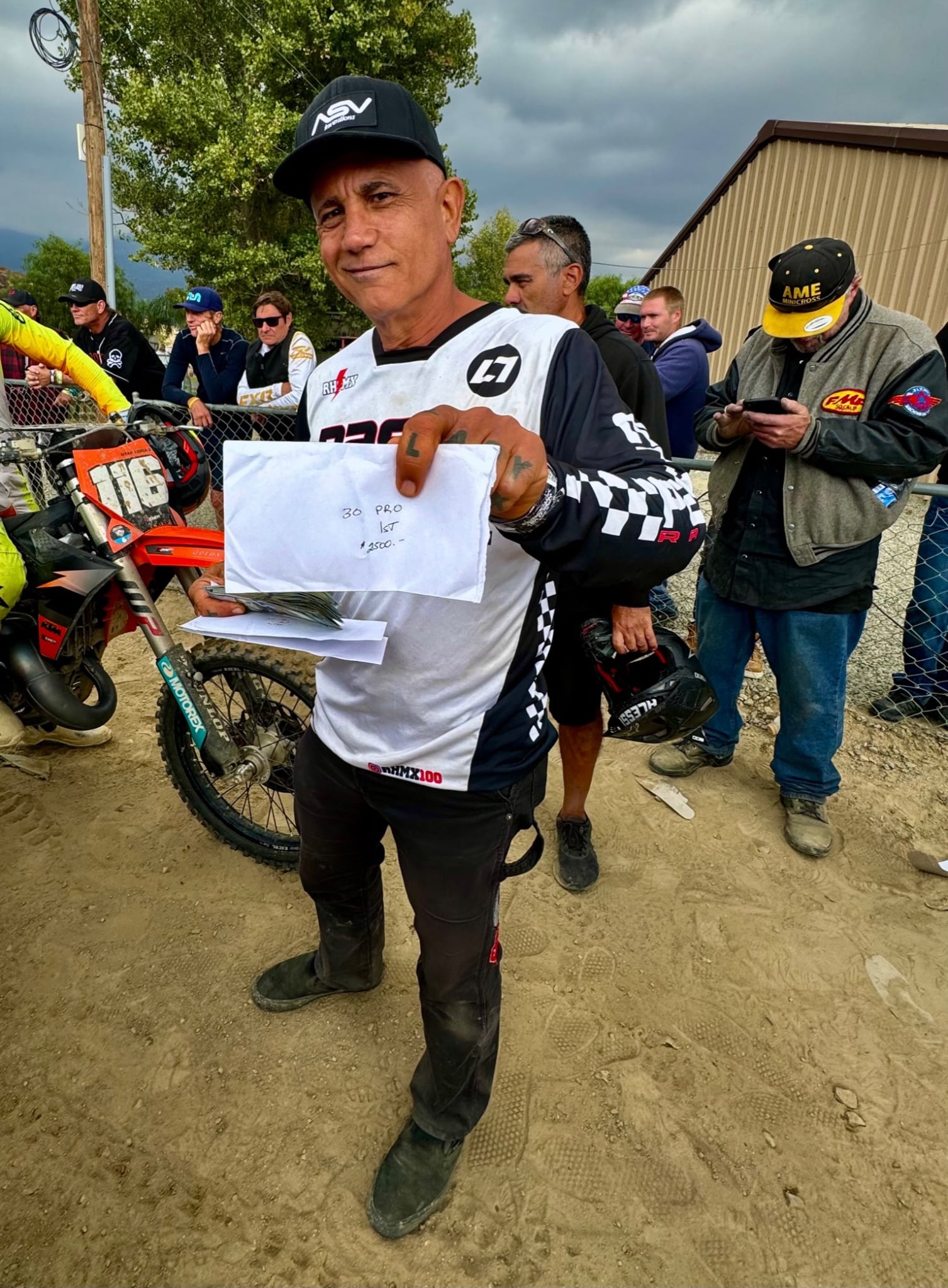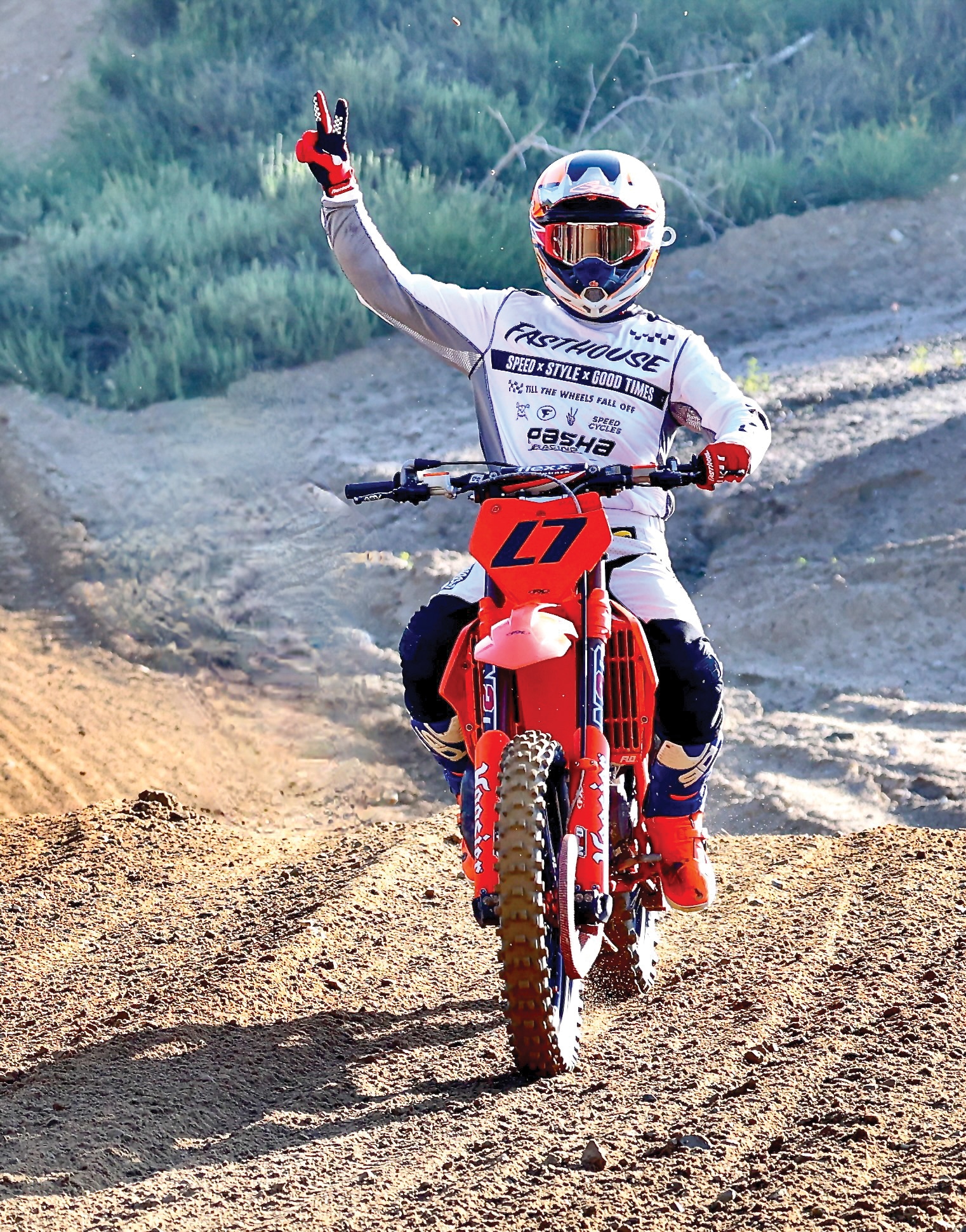TWO-STROKE TUESDAY: THE AMAZING JOURNEY OF TWO-STROKE EMPRESSARIO PASHA AFSHAR

BY JIM KIMBALL
PASHA, WAS IT IN 2019 WHEN YOU BEGAN SPONSORING THE 125 TWO-STROKE CHAMPIONSHIPS AT GLEN HELEN? Yes, but before that, I had a team of kids trying to race the AMA Nationals and Supercross for well over a decade and a half. I have always been involved in supporting kids in racing, and still am. My focus at that time was a team that raced Supercross and Outdoor Nationals. I have had many riders throughout the years that I helped. About four years ago, my focus then turned to holding a 125 two-stroke racing series, instead of having a team.
SO, YOU BECAME A RACE PROMOTER. Yes, I went from team owner to promoter. The reason I started investing money into promotion and purse money rather than helping individual racers was because a lot of the riders were not as thankful as they should have been. They were not as appreciative. They did not try, nor commit, as hard as they could have. Everybody knows that motocross is a life commitment. You can’t fake it.
A lot of these young pro guys were entitled, and they felt that everybody owed them something. It turned out to be a huge waste of money on some riders. With others, it turned out great, and those riders are still riding for me today.
Unfortunately, if you sponsored 100 riders, you would be lucky if 20 were committed, and from those, 10 were really, really committed. Finally, from that small group of really committed, only two had the talent to even make it into the mains. With the small percentage of riders that make it, I swear it is better to go buy a lottery ticket.
SPONSORING RACERS CAN SEEM LIKE A MONEY PIT. I thought, “I am wasting hundreds of thousands of dollars a year trying to get these kids to just qualify.” But, even when they did qualify, they were finishing near last. The highest-placing guy I helped was Sean Collier, who is still under our wing. He is one of the guys that still rides with us 15 years later. Sean was with Star Yamaha for a while.

WHAT MADE YOU DECIDE TO SPEND YOUR SPONSORSHIP MONEY A BIT DIFFERENTLY? I told myself, “Instead of spending $20,000 on a bike, I will spend $20,000 on purse money so that local pros and aspiring AMA National guys can win money. I wanted to have smashing events and let the racers ride their hearts out and earn purse money that normally they would never have gotten, because there is no money in local motocross.
“I TOOK THE MONEY I WAS SPENDING ON SPONSORING A TEAM, AND I STARTED PROMOTING TWO-STROKE PURSE RACES. I WAS GOING TO LOSE THE MONEY ANYWAY, SO I MIGHT AS WELL TRY TO HAVE 10 GUYS WALK AWAY WITH SOMETHING FOR THEIR EFFORT.”
LET’S HEAR MORE. Not only will the winners take advantage of the cash, but the other 150 riders will have a fantastic day of racing. I focused on 125 two-stroke racing because of the sounds the 125s make and because everybody has the best days of their lives on a two-stroke. I wanted to have three gates of 40 men racing two-strokes. What could be better than that?
I took the money I was spending on sponsoring a team, and I started promoting two-stroke purse races. I was going to lose the money anyway, so I might as well try to have 10 guys walk away with something for their effort.
IS IT TRUE THAT BACK IN THE 1970s SOCAL RACERS COULD MAKE MORE MONEY RACING AT HOME THAN GOING TO THE AMA NATIONALS? Absolutely. They could make a decent living! In SoCal, you could race a couple of days a week at Saddleback, Indian Dunes, Carlsbad, OCIR and Ascot. You can’t do that anymore.

THE TIMES ARE MUCH DIFFERENT TODAY. Yes. Back in the day, there used to be four gates of 125 Novices alone. Right now, you’re lucky if your local track can find enough 125 two-strokes for one gate. Motocross, even at the local level, has become very expensive. Even if you own a bike, you still must pay entry fees, buy gas, pay a gate fee and burn through tires, sprockets and chains—and that doesn’t count upkeep and maintenance. The people who run the sport and profit from it are squeezing it to death with crazy prices.
I felt that there was a huge void in our sport. There is something wrong with the way the powers that be manipulated the sport. I don’t have the answer, but I do have the cure. So, I started promoting two-stroke racing for three reasons: One, it is cost effective. Two, two-strokes are more fun to race—no doubt on that point. Three, racing a two-stroke is so much safer than a four-stroke.
Four-strokes have too much power. They are too heavy, too technical and too dangerous. The human body can only handle so much horsepower, weight and inertia before it is overwhelmed. Most people aren’t James Stewart, Chase Sexton or Ken Roczen.

WITH YOUR PASHA 125 OPEN PRO TWO-STROKE CHAMPIONSHIPS, ARE YOU TRULY ENJOYING THE SPORT? Motocross is the best/worst sport on earth. People are making a mistake right now by buying four-strokes. If people stopped buying four-strokes, the manufactures would have to go back to two-strokes. First, it is a lot cheaper to maintain a two-stroke. When a two-stroke blows up, you can get a top end for a few hundred bucks and do it yourself. If a four-stroke blows up, it is going to cost you four grand. This four-stroke situation, and the way the economy is headed, has pushed everybody to the brink of not being able to afford to race.
ROGER DECOSTER WAS ASKED ABOUT HOW TO LESSEN SUPERCROSS INJURIES, AND HE SAID THAT THE QUICK ANSWER WOULD BE TO RETURN TO TWO-STROKES. It could happen. If everybody stopped buying four-strokes, two-strokes would come back. KTM makes two-strokes and sells them like hotcakes. Go to any off-road race in Europe or America and you might not find the factory riders on two-strokes, but everyone else is on one.
WHEN WAS THE MOMENT YOU BECAME INFATUATED WITH TWO-STROKE RACING? I had a buddy who was bugging me to buy a SuperMini. He was heavily involved in adult Supermini racing, and he got me to enter a race when I was 50 years old. It reminded me of when I was young and I raced for fun. And when you race for fun, somehow you go faster, right? Coming off a 450, I felt like Arnold Schwarzenegger on the bike because I could throw that thing around like a bicycle.
WHEN DID YOU MOVE TO A 125? My four-stroke mechanic at that time was Terry Varner, and he showed up with a Yamaha YZ144 that he had built for another client and said, “Hey, Pasha, why don’t you take it for a spin. It is a full-race YZ144 for Connor Eddy. I just took it off the dyno. It has never been ridden. Go check it out.” Within two laps I was in love with my high school girlfriend again. I bought a new 125 the next day.

“I AM HOPING TO GET THE ATTENTION OF SOME OUTSIDE SPONSORS WHO WANT TO TAP INTO A MARKET OF ATHLETIC, CLEAN-LIVING, ENERGETIC PEOPLE WHO RACE MOTORCYCLES ON THE WEEKENDS.”
IS THAT WHAT GOT YOU INTO PROMOTING 125 PRO RACES? Yes. One day in 2019 I was at Fasthouse, who sponsors me. I told owner Kenny Alexander, “I’m thinking about throwing a 125 Pro race at REM Glen Helen.”
He said, “Great idea.” We started just like that. Nothing was planned, absolutely nothing. It was insane. Everybody pulled their old 125s out from under the rocks and showed up. It turned out to be the most fun, exciting thing anybody had ever done. It was insane.
FROM THAT ONE RACE IT EXPLODED? Yes, it grew and grew and grew, and now we have National guys like Jeremy McGrath, Mike Alessi, Mike Brown, Sean Collier, Carson Brown, Kurt Nicoll, Ryan Morais, Doug Dubach and Josh Mosiman racing. Wehave hosted Pasha 125 Pro Opens at the Hangtown National, World Two-Stroke Championship, World Vet Championship and I still hold local two-stroke races at Glen Helen.
I have been lucky that a few people share my mentality, like Nick Mairose at Elite Media Technologies, Kenn Kibby of Motocross Ministry, the Twisted Development guys, Haeseker Racing Engines, Hoosier Tires and Electron Carburetors. All sorts of two-stroke companies have pitched in, given away parts, helped organize the events and contributed to the purse money. Our purse from our first race started at $1500 and quickly grew to $20,000.
I don’t run the races. We piggyback our three Pasha 125 Open classes on the existing events. Our smallest ever purse was $15,000 split between the three classes. I don’t take any money from the riders’ entry fees (that goes to the promoter of that event). I just spend money to make it happen.

WHAT ARE YOU HOPING WILL HAPPEN IN THE FUTURE? I am hoping to get the attention of some outside sponsors who want to tap into a market of athletic, clean-living, energetic people who race motorcycles on the weekends. I want someone who has nothing to do with dirt bikes to get into the motocross market as a sponsor. How awesome would it be to have some company like Mrs. Field’s Cookies on your shroud.
HOW DID YOU GET IT TO GROW SO FAST? I tried to spread the word through the motocross media. I didn’t have much success with most of them, but I race every single weekend at the same tracks as the MXA wrecking crew. I told them what I wanted to do way back in 2019, and they said that they would help me. I would estimate that 95 percent of my success comes from Motocross Action Magazine. They are strong two-stroke supporters, and I could not have done it without their advice and race coverage.
HOW YOU ARE ABLE TO DO THIS FINANCIALLY? I’m in the movies as an actor with the screen name “Tony Panterra,” and I am a stunt driver. Outside of the movie industry, I am a general contractor. When I am not doing movies, I do construction. Between Hollywood and construction, I survive. I thank the Lord that I have enough money to play with. I work seven days a week. I am on the phone 24 hours a day. I literally work between motos.

TALK MORE ABOUT YOUR ACTING. Hollywood was like an unexpected dream. Not only did I fall into it by luck, but I was also lucky in that I was able to go straight to doing stunts in some of the biggest action movies of the time. My first job was in “Terminator 2,” where I doubled for the Liquid Mercury cop. I did the live action before the CGI was applied. As a motocross racer, being a stuntman just fits the bill. Almost all Hollywood stuntmen were motorcycle racers. I have worked on and acted in over 60 films and TV shows.
YOUR BROTHER IS INVOLVED IN THE MOVIE INDUSTRY, ISN’T HE? My brother followed in my footsteps. He is seven years younger than I am. His name is Ali, and he is an independent movie producer at Warner Brother’s studio. We started making our own movies, originally produced and funded by Lucas Oil.
“I WON’T GO IN TO TOO MUCH DETAIL. I STRUGGLED BAD, BUT I FELL IN LOVE WITH THE SPORT. IT WAS MY NEW LIFE, AND I LOVED IT AND WANTED TO DO IT. NOTHING ELSE MATTERED.”
IS IT TRUE THAT YOU TALKED YOUR BROTHER INTO MAKING A MOTOCROSS MOVIE CALLED “BENNETT’S WAR”? It was not a motocross movie; it is a real Hollywood movie with motocross as the central theme. I had a cameo role. Unfortunately, it did not do well at the box office because it was not a major studio release. It was an independent movie, but everyone who saw it loved the movie. We did location shoots at Glen Helen Raceway during an AMA National. Our marketing was aimed at the motocross and off-road worlds, which is a tiny sliver of the movie-going audience. When you look at the big scheme of things, not everybody has a dirt bike.
BUT, IT MUST BE A HIGHLIGHT OF YOUR MOTOCROSS LIFE TO HAVE PITCHED A HOLLYWOOD MOTOCROSS FILM AND GOTTEN IT MADE. I did not have the opportunity to do these things when I was younger. I could have been an AMA National Champion. I know every rider says that, but my greatest loss was that I did not have the opportunity to live my dream.
WHY COULDN’T YOU REALIZE YOUR DREAM? I was born in the 1960s in the country of Iran, which is a Middle Eastern country that was in turmoil. Motorcycles and motorcycle racing were non-existent in the culture of Iran. There was no motorcycle racing. It did not exist. But, even at an early age, I loved motorcycles.
WHAT WAS THE FIRST MOTORCYCLE YOU SAW UP CLOSE? We had a gardener, and the gardener’s son had a motorcycle. We are talking when I was 8 years old. I liked to stare at the motorcycle, which I now know was a 1974 Yamaha GT80. Later my cousin got a Honda Monkey 50, and I remember I would ride on the back when we went to the beach. I was just a passenger on the back of my cousin’s Monkey, and I couldn’t even imagine what was happening on the other side of the world. One day I saw a copy of Motocross Action Magazine that had been smuggled into Iran. It was illegal to have it, but for that brief moment I knew what I wanted to do.
BUT YOU COULDN’T ACHIEVE THAT DREAM IN IRAN. No, after the overthrow of the Shah of Iran, the government and the politics forced my family to get out of Iran. At first we moved to England, where I could look at motorcycles through the shop windows and watch the people ride by on the street.
In 1979, we moved to Northern California, and dad bought 160 acres in Petaluma (down the road from where Josh Mosiman was raised and his parents still reside). I badgered my dad endlessly, and I finally got him to buy me a 1979 Yamaha YZ100 so I could ride on our property. When I was 15 years old, I got a job at McDonald’s and went straight to San Rafael/Marin County Yamaha and bought my first real bike—a 1981 Yamaha for $895.00 (I had payments of $60.00 a month). So, I had a bike and a place to ride, but instead I got my driver’s license and my life turned to picking up girls, drinking beer, ditching cops and doing the redneck thing.
WASN’T THERE A MOVIE ABOUT THAT? Yes. My brother and I did a movie about our life. It is called “American Wrestler, The Wizard.” It is a true story of an Iranian family coming to America in 1979. It includes the lifestyle of not being an American, coming to America, and the things we had to deal with in the 1970s and early 1980s. But, it does touch on the cruising, hot rods, girls, 1969 Camaros, four-wheel-drive trucks and street racing.

WHERE DID YOUR MOTOCROSS DREAM FINALLY COME TRUE? Eventually, we moved to Southern California because my mother had cancer and needed to be close to the UCLA Center for Cancer Research. In 1995 I realized that something was missing from my life—that thing was a dirt bike. I walked into Kolbe Honda/Yamaha in Woodland Hills and bought a 1995 WR250. I had no connections to racetracks or knowledge of any, but luckily I had a friend who owned a KX500 and ran a Harley repair shop in Venice, California. He said that there was a motocross track about an hour away.
I had never ridden on a motocross track in my life. I was 28 years old, about the age when most motocross racers retire, and I was just starting. LACR (Los Angeles County Raceway) was the place, and a big series race was in full swing when I showed up on my 1995 WR250 ready to conquer the world. I won’t go in to too much detail. I struggled bad, but I fell in love with the sport. It was my new life, and I loved it and wanted to do it. Nothing else mattered.
I have paid big time with broken bones and all sorts of things, but motocross is my life. If you took that away from me or if I could not ride, it would be the end—the depression, the misery. I must ride until I can’t ride anymore. I will probably go into my grave with my motorcycle.
PASHA, HOW SHOULD WE FINISH? First, I’d love to take a minute to say thank you to my sponsors. I owe much gratitude to ASV Inventions, Rekluse Clutch, FMF, ZRT, AME Grips, Dubya Wheels, Hoosier Tires, Guts Seats, Dirt Tricks Sprockets, P3 Carbon, Lectron/Billetron Carbs, Throttle Syndicate, Faast Company Flexx Bars, Fastway Pegs, FLO, FCP mounts, Ride Engineering, Coppersmith Racing Suspension, ESR Suspension, Haeseker Racing Engines, Twisted Development, Varner Motorsports, Maxima, Fuel Factory Race Gas, 3 Bros, Langston, AEO/REP, Simi Valley Cycles, Ken and Amp; Joes Dealership, TRE/The Racers Edge, MXFS, DT1 Filters, and Moto Tassinari Reeds.
Finally, we are always looking for more sponsors for the upcoming race series! Hit me up on Instagram at pasharacing.







Comments are closed.